Identifying Flowers
Flower #1
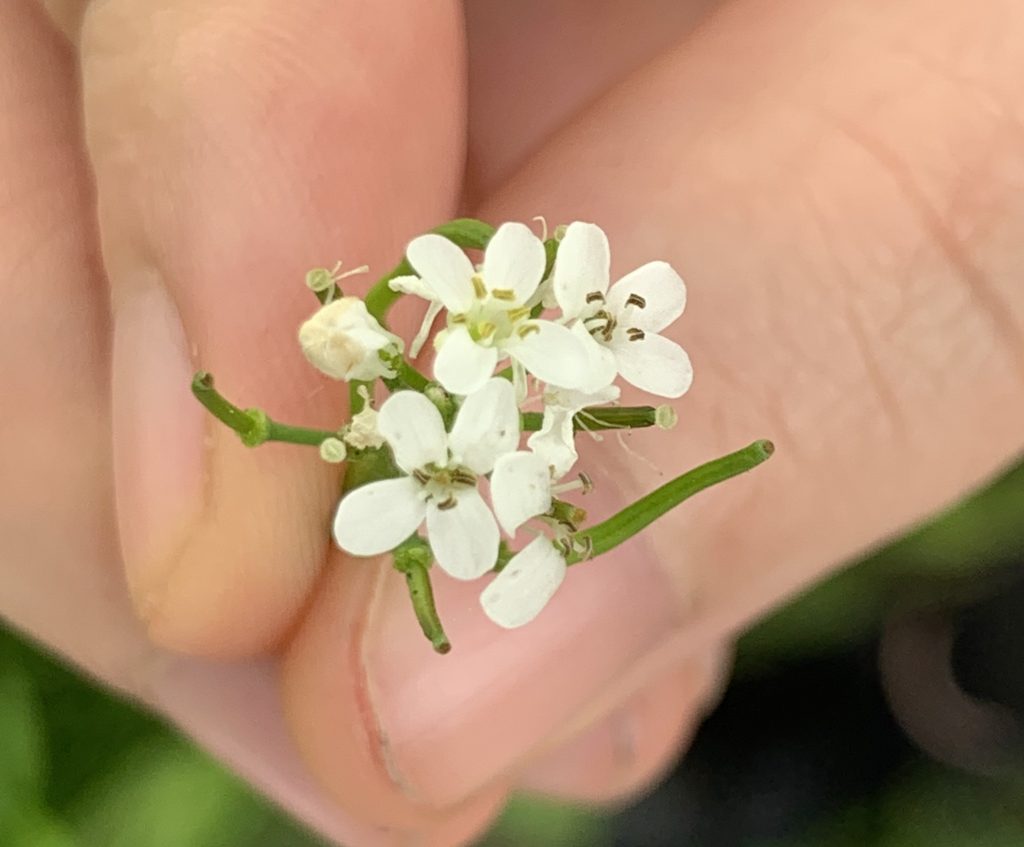
Garlic mustard, Alliaria officinalis
This flower was found here (location and habitat/environment): at Antrim Park, in a wooded area near the walking path
It is on page 138 in Newcomb’s Wildflowers.
Common name: garlic mustard Scientific name: Alliaria officinalis
Corolla: number of petals – 4 separate or fused? – separate
Calyx: number of sepals – 4 separate or fused? – separate
Adroecium: number of stamens – 6 (4 long, 2 short) separate, fused or arranged in any special way?
separate, arranged around the pistil in a whorl, between petals and pistil
Gynoecium type: unicarpellate, apocarpous, or syncarpous (and # of carpels =_____)
How can you tell? (Cite the features were apparent about the number of carpels.)
syncarpous, consisting of 2 carpels (2 stigma lobes can be distinguished, although carpels are fused)
Flower type/ovary position: Hypogynous, or perigynous or epigynous? – hypogynous
Flower symmetry: actinomorphic (regular) or zygomorphic (irregular)? – actinomorphic (regular)
Additional distinctive features: This plant often has a garlic scent, especially when the leaves are crushed
———————————————–
Flower #2
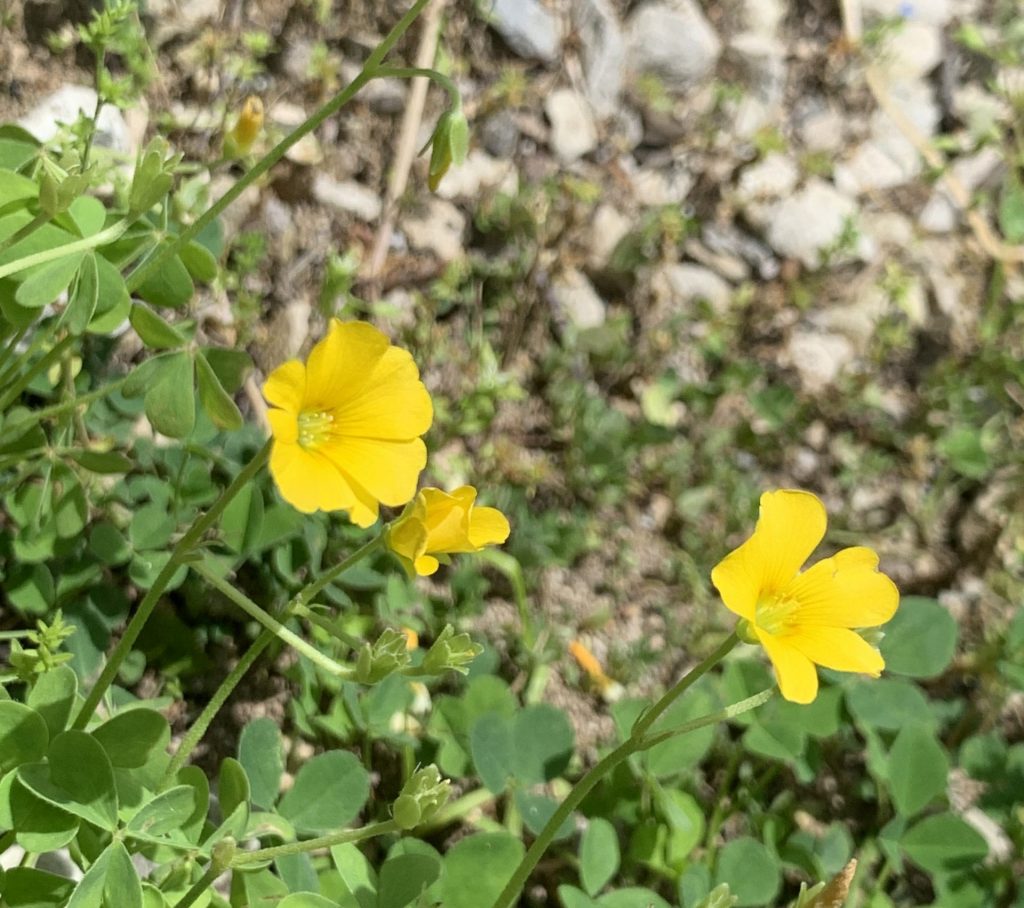
Yellow wood sorrel, Oxalis europaea
This flower was found here (location and habitat/environment): Antrim park, in a grassy area a few feet from the walking path
It is on page 246 in Newcomb’s Wildflowers.
Common name: yellow wood sorrel Scientific name: Oxalis europaea
Corolla: number of petals – 5 separate or fused? – separate
Calyx: number of sepals – 5 separate or fused? – separate
Adroecium: number of stamens – 10 separate, fused or arranged in any special way?
fused, arranged around the pistil and fused at the base
Gynoecium type: unicarpellate, apocarpous, or syncarpous (and # of carpels =_____)
How can you tell? (Cite the features were apparent about the number of carpels.)
syncarpous, with 5 carpels (5 stigma lobes that separate at the top, with styles fused at the base)
Flower type/ovary position: Hypogynous, or perigynous or epigynous? – hypogynous
Flower symmetry: actinomorphic (regular) or zygomorphic (irregular)? – actinomorphic (regular)
Additional distinctive features: Although similar to the great wood sorrel, the flowers are small, only 1/4″ to 1/2″ wide
———————————————–
Flower #3
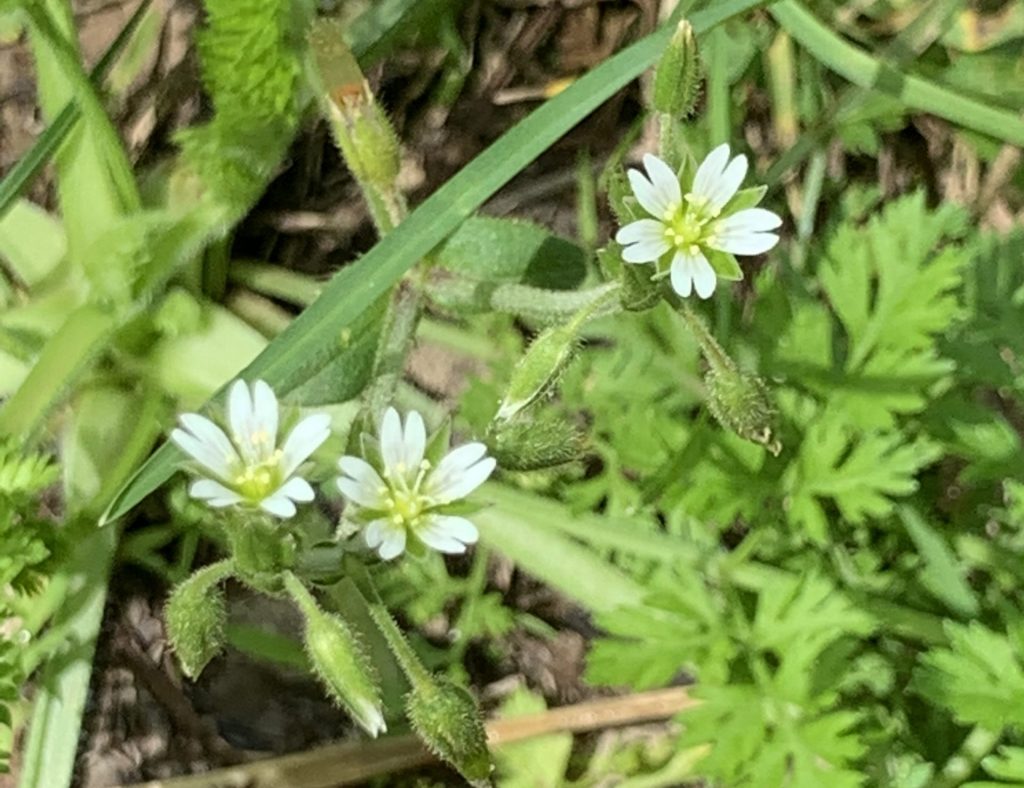
Mouse-ear chickweed, Cerastium vulgatum
This flower was found here (location and habitat/environment): Antrim Park, in a grassy area a few feet from the walking path
It is on page 274 in Newcomb’s Wildflowers.
Common name: mouse-ear chickweed Scientific name: Cerastium vulgatum
Corolla: number of petals – 5 separate or fused? separate
Calyx: number of sepals – 5 separate or fused? separate
Adroecium: number of stamens – 10 separate, fused or arranged in any special way?
separate, arranged in a whorl around the pistil
Gynoecium type: unicarpellate, apocarpous, or syncarpous (and # of carpels =_____)
How can you tell? (Cite the features were apparent about the number of carpels.)
syncarpous, with 5 carpels (there are 5 fused styles and stigma lobes)
Flower type/ovary position: Hypogynous, or perigynous or epigynous? – hypogynous
Flower symmetry: actinomorphic (regular) or zygomorphic (irregular)? – actinomorphic (regular)
Additional distinctive features: The petals are cleft, like other chickweed species, but the cleft is only about half the length of the petals
———————————————–
Flower #4
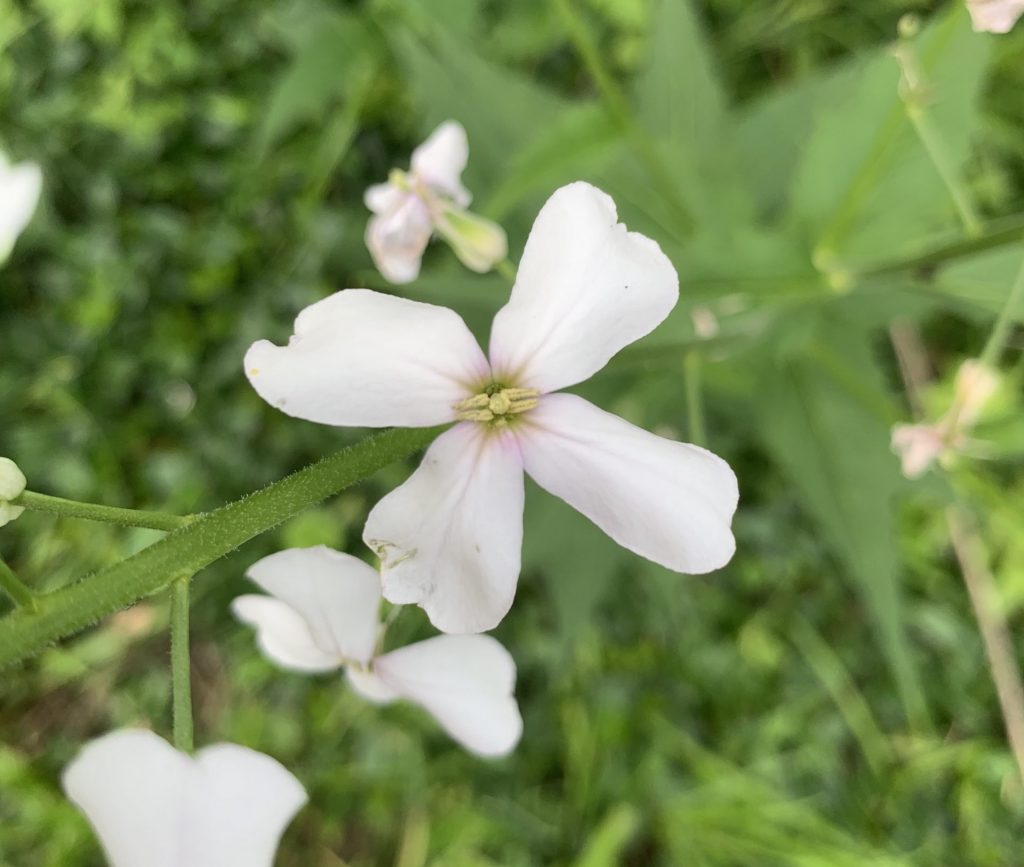
Dame’s violet, Hesperis matronalis
This flower was found here (location and habitat/environment): Antrim Park, in a grassy area near some shrubs and small trees
It is on page 138 in Newcomb’s Wildflowers.
Common name: dame’s violet or dame’s rocket Scientific name: Hesperis matronalis
Corolla: number of petals – 4 separate or fused? separate
Calyx: number of sepals – 4 separate or fused? separate
Adroecium: number of stamens – 6 (4 long, 2 short) separate, fused or arranged in any special way?
separate, arranged around the pistil in a whorl
Gynoecium type: unicarpellate, apocarpous, or syncarpous (and # of carpels =_____)
How can you tell? (Cite the features were apparent about the number of carpels.)
unicarpellate (only one stigma and style are seen, and a cross section would reveal one chamber)
Flower type/ovary position: Hypogynous, or perigynous or epigynous? – hypogynous
Flower symmetry: actinomorphic (regular) or zygomorphic (irregular)? – actinomorphic (regular)
Additional distinctive features: This plant ranges in color, from pink-purple to white to violet, as seen below.
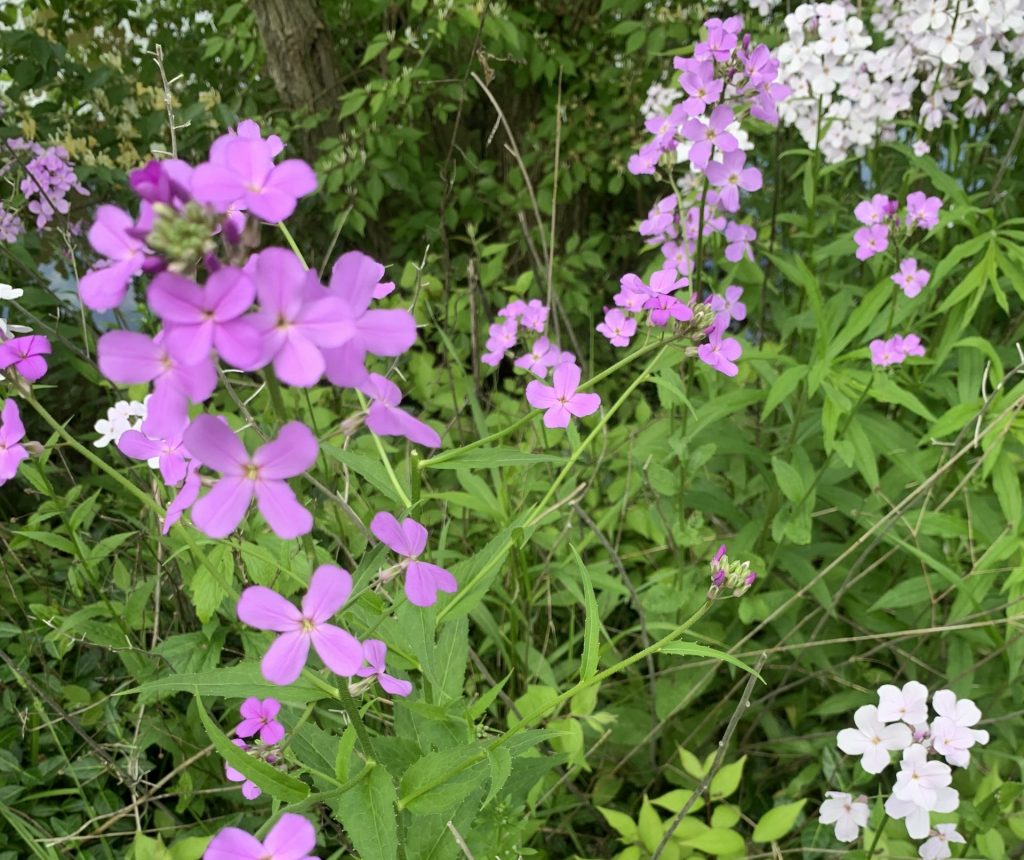
more colors of dame’s violet
———————————————–
Flower #5
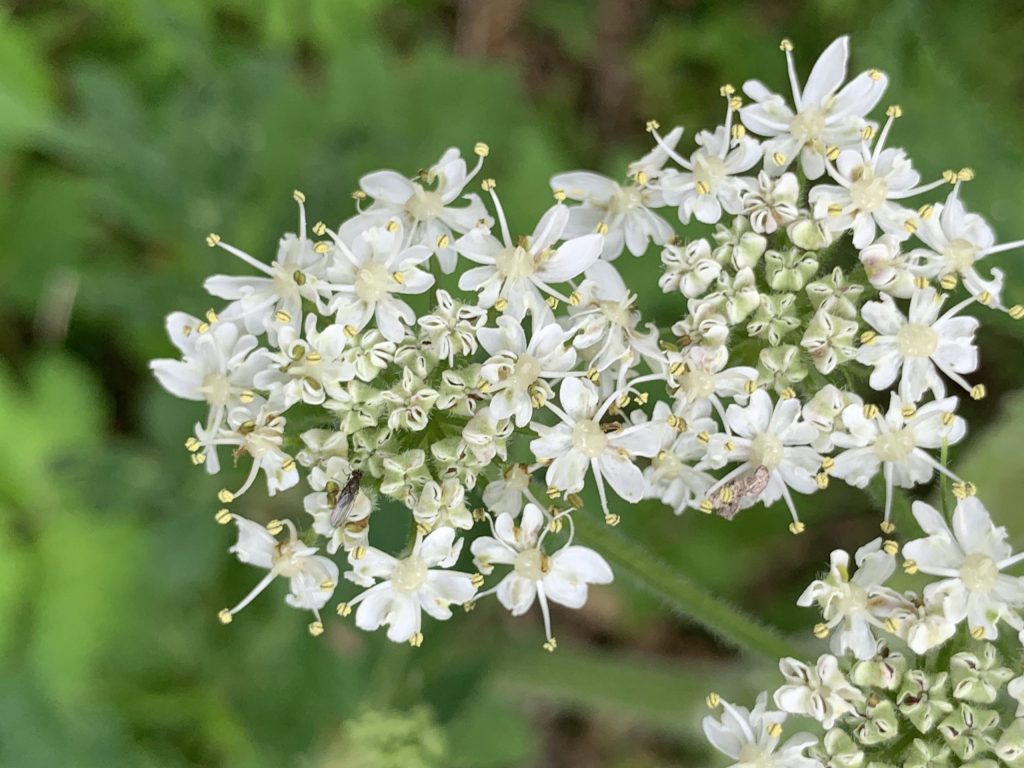
Cow parsnip, Heracleum maximum
This flower was found here (location and habitat/environment): Antrim Park, at the edge of a forested area
It is on page 218 in Newcomb’s Wildflowers.
Common name: cow parsnip Scientific name: Heracleum maximum
Corolla: number of petals – 5 separate or fused? – separate
Calyx: number of sepals – 5 separate or fused? – separate
Adroecium: number of stamens – 5 separate, fused or arranged in any special way?
fused at the base, arranged in line with sepals
Gynoecium type: unicarpellate, apocarpous, or syncarpous (and # of carpels =_____)
How can you tell? (Cite the features were apparent about the number of carpels.)
syncarpous, with 2 fused carpels (2 styles and stigma lobes can be seen)
Flower type/ovary position: Hypogynous, or perigynous or epigynous? – epigynous
Flower symmetry: actinomorphic (regular) or zygomorphic (irregular)? – actinomorphic (regular)
Additional distinctive features: Cow parsnip has a very thick stalk and very large leaves, and the flowers are arranged in clusters.
———————————————–
Flower #6
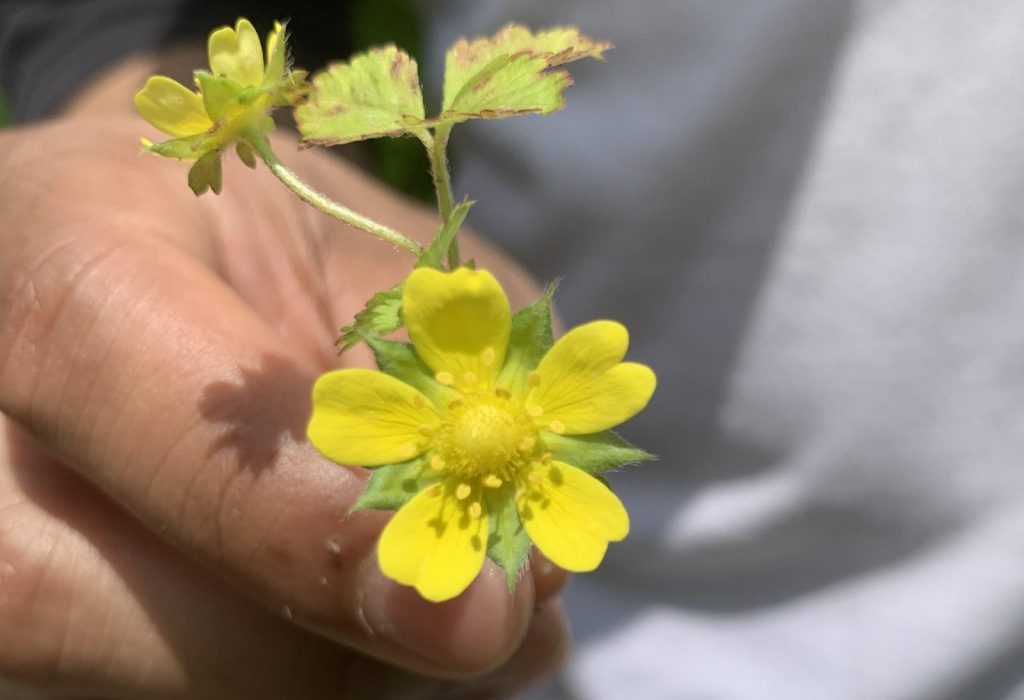
Indian strawberry, Duchesnea indica
This flower was found here (location and habitat/environment): Antrim Park, in a grassy area midway between the walking path and forest edge
It is on page 240 in Newcomb’s Wildflowers.
Common name: Indian strawberry Scientific name: Duchesnea indica
Corolla: number of petals – 5 separate or fused? – separate
Calyx: number of sepals – 5 separate or fused? – separate
Adroecium: number of stamens – 20 separate, fused or arranged in any special way?
separate, arranged alternately in a whorl around the pistil
Gynoecium type: unicarpellate, apocarpous, or syncarpous (and # of carpels =_____)
How can you tell? (Cite the features were apparent about the number of carpels.)
syncarpous, with many carpels (many stigma lobes and styles can be seen and a cross section shows many chambers)
Flower type/ovary position: Hypogynous, or perigynous or epigynous? – perigynous
Flower symmetry: actinomorphic (regular) or zygomorphic (irregular)? – actinomorphic (regular)
Additional distinctive features: These plants bear fruit that look very similar to true strawberries, usually bright red in color.
———————————————–
Flower #7
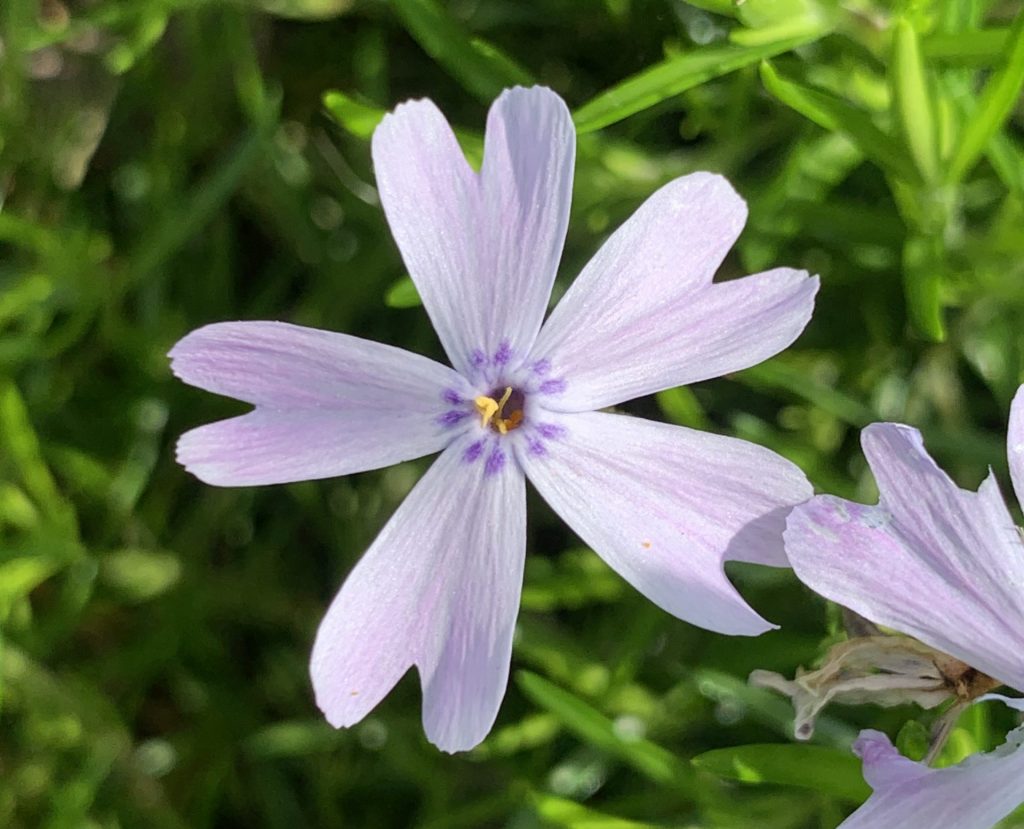
Cleft phlox, Phlox bifida
This flower was found here (location and habitat/environment): in a cultivated area in front of a sign in my neighborhood
It is on page 246 in Newcomb’s Wildflowers.
Common name: cleft phlox or sand phlox Scientific name: Phlox bifida
Corolla: number of petals – 5 separate or fused? – fused
Calyx: number of sepals – 5 separate or fused? – fused
Adroecium: number of stamens – 5 separate, fused or arranged in any special way?
separate, attached at the base of the petals and in line with the sepals
Gynoecium type: unicarpellate, apocarpous, or syncarpous (and # of carpels =_____)
How can you tell? (Cite the features were apparent about the number of carpels.)
syncarpous, with 3 carpels (3 stigma lobes separate from styles and lead to a single ovary)
Flower type/ovary position: Hypogynous, or perigynous or epigynous? – hypogynous
Flower symmetry: actinomorphic (regular) or zygomorphic (irregular)? – actinomorphic (regular)
Additional distinctive features: Unlike other phlox, cleft phlox petals are cleft to about the middle, distinguishing them from other species.
———————————————–
Flower #8
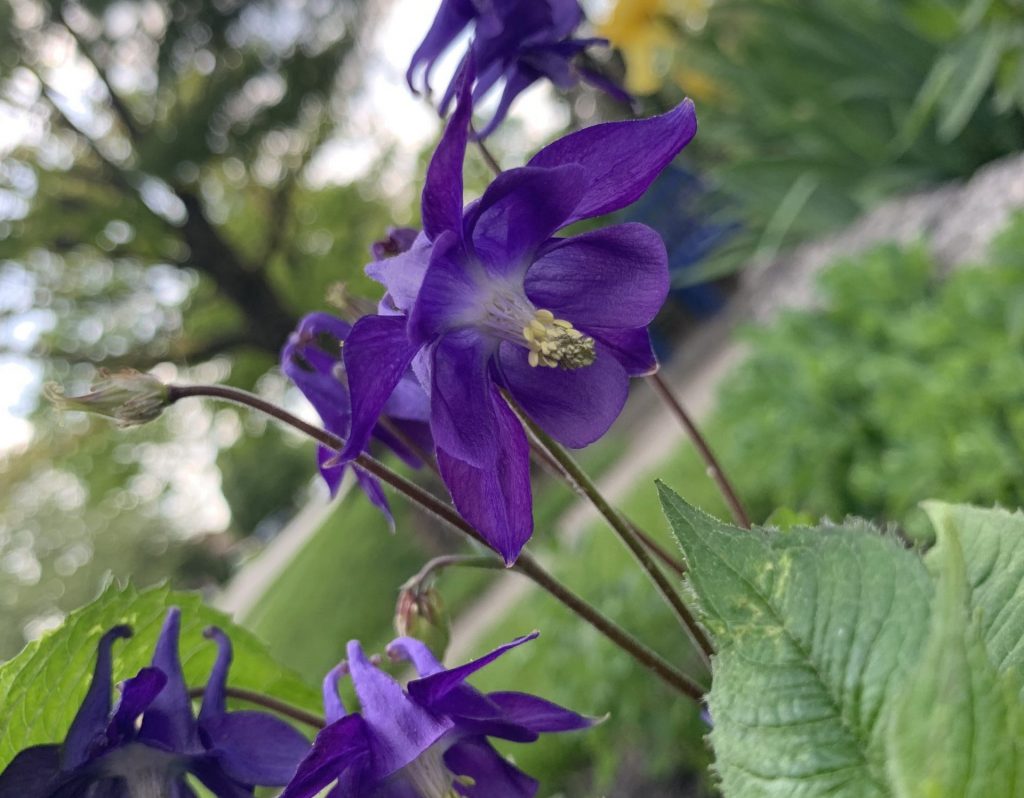
Garden columbine, Aquilegia vulgaris
This flower was found here (location and habitat/environment): in a cultivated garden area in my neighborhood
It is on page 228 in Newcomb’s Wildflowers.
Common name: garden columbine or European columbine Scientific name: Aquilegia vulgaris
Corolla: number of petals – 5 separate or fused? – separate
Calyx: number of sepals – 5 separate or fused? – separate
Adroecium: number of stamens – ~20, usually more than 15 separate, fused or arranged in any special way?
separate, closely attached in a whorl around the pistil
Gynoecium type: unicarpellate, apocarpous, or  syncarpous (and # of carpels =_____)
How can you tell? (Cite the features were apparent about the number of carpels.)
apocarpous, with varying number of carpels (4 stigma lobes and styles could be seen on one flower, not fused to one another)
Flower type/ovary position: Hypogynous, or perigynous or epigynous? – hypogynous
Flower symmetry: actinomorphic (regular) or zygomorphic (irregular)? – actinomorphic (regular)
Additional distinctive features: The flowers have a deep violet shade, and the leaflets grow in triplets and are deeply lobed.
———————————————–
“Many eyes go through the meadow, but few see the flowers in it”
– Ralph Waldo Emerson
